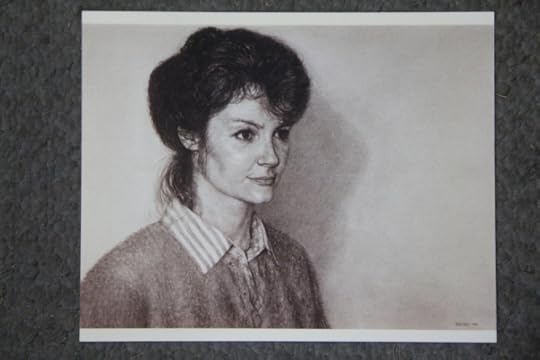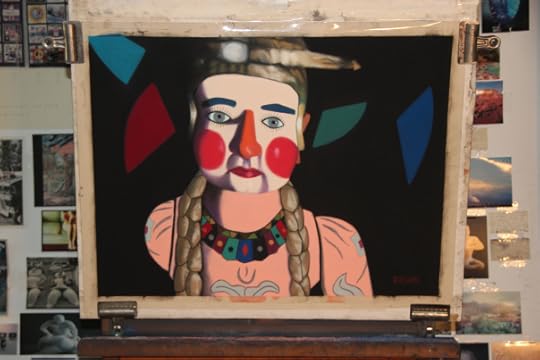Barbara Rachko's Blog, page 128
September 27, 2014
Q: How did you prepare yourself to change careers and work as a professional artist?

“Krystyn,” charcoal, 22″ x 30″, 1989
A: At the age of 33 I was a Lieutenant in the Navy, working as computer analyst at the Pentagon. I was very unhappy with my job. I began looking for something else to do and discovered The Art League School in Alexandria, VA. I enrolled in classes with Lisa Semerad, then spent the next two years developing my drawing skills using black and white media (charcoal, pencils, conte crayon, etc.).
After that I moved on to color media and began studying soft pastel with Diane Tesler. During this time I was still in the Navy, working the midnight shift at the Pentagon and taking art classes during the day. I was a very motivated student.
After three years or so I was getting quite proficient as an artist, entering local juried shows, winning prizes, garnering press coverage, etc. Prior to my career change, I worked hard to develop my portrait skills. I really didn’t know how I could make a living other than by making commissioned portraits. I volunteered to run a weekly life drawing class at The Art League School in Alexandria, VA, where I made hundreds of figure drawings using charcoal.
I spent a semester commuting between Washington, DC and New York to study artistic anatomy at the New York Academy of Art. I spent another semester studying gross anatomy with medical students at Georgetown University Medical School. Over time I became skilled at making photo-realistic portraits. In 1989 I resigned from the Navy and have worked full-time as a visual artist ever since.
Comments are welcome!
Filed under: An Artist's Life, Creative Process, Inspiration, Pastel Painting, Photography, Working methods Tagged: Alexandria_VA, artistic anatomy, black and white, career, change, charcoal, classes, color, commissioned, commuting, computer analyst, conte crayons, developing, Diane Tesler, drawing, enrolled, entering, figure drawings, full-time, garnering, Georgetown University Medical School, gross anatomy, juried shows, Krystyn, lieutenant, life drawing, LIsa Semerad, living, local, looking, media, midnight shift, motivated, Navy, New York, New York Academy of Art, pencils, Pentagon, photo-realistic, portrait, portraits, prepare, press coverage, prizes, professional, proficient, resigned, semester, skilled, skills, soft pastel, student, students, studying, The Art League School, unhappy, visual artist, volunteered, Washington_DC, winning, work








September 24, 2014
Pearls from artists* # 110

Barbara’s studio
* an ongoing series of quotations – mostly from artists, to a rtists – that offers wisdom, inspiration, and advice for the sometimes lonely road we are on.
A well-lived life should be worth attention. At the very least, you should find your own story engaging. In presenting yourself to yourself and others, then, you should keep in mind the rules that good playwrights follow. Like a good character – you should be making choices that are explicable – choices that appear to be coming from a mind in working order. Your choices should be reasonably coherent with each other, also, so as to support the thought that there is a real person – you – behind those choices.
Paul Woodruff, philosopher, quoted in What’s the Story: Essays about art, theater, and storytelling by Anne Bogart
Comments are welcome!
Filed under: An Artist's Life, Art in general, Art Works in Progress, Black Paintings, Creative Process, Inspiration, New York, NY, Pastel Painting, Pearls from Artists, Photography, Quotes, Studio, Working methods Tagged: "What's the Story: Essays about art theater and storytelling, Anne Bogart, appear, attention, character, choices, coherent, coming, engaging, explicable, follows, good, life, making, mind, order, others, Paul Woodruff, pearls from artists, person, philosopher, playwright, presenting, real, reasonably, rules, story, support, thought, well-lived, working, yourself








September 20, 2014
Q: What in your opinion marks a work of art as contemporary?

West 26th Street, NYC
A: “C ontemporary art” is defined formally as art made since 1970 by living artists who are still making new work. People often confuse the term “contemporary art” with “modern art,” but they are not the same. “Modern art” refers to art made during the period between, roughly, the 1860’s to 1970.
Nowadays there are so many different kinds of art – new forms are developing all the time – and almost anything can be considered contemporary art as long as someone, an artist, says it is art. Ours is a fascinating, but bewildering, crazy, and often silly art world. Since I am based in New York, I see a lot that makes me ask, “Is this really art?” and “Why would anyone make such a thing?”
If there is one single element I look for in visual art it would have to be a high degree of craft. I enjoy seeing work that is beautiful, well-crafted, and that makes me wonder how the artist made it. With the exception of Ai Weiwei and Julie Mehretu (maybe others I can’t think of just now), I prefer art made by a single creator, as opposed to artists like Jeff Koons or Damien Hirst, who employ dozens of people to make their work.
Comments are welcome!
Filed under: An Artist's Life, Art in general, Creative Process, New York, NY, Photography Tagged: "contemporary art", "modern art", anything, art world, artist, beautiful, bewildering, confuse, considered, craft, crazy, Damien Hirst, defined, degree, developing, dozens, element, employ, fascinating, formally, forms, Jeff Koons, Julie Mehretu, living, Marks, New York, NYC, opinion, people, period, pratically, seeing, silly, single, someone, term, time, visual art, well-crafted, West 26th Street, wonder, work of art








September 17, 2014
Pearls from artists* # 109

A few of Barbara’s pastels
* an ongoing series of quotations – mostly from artists, to a rtists – that offers wisdom, inspiration, and advice for the sometimes lonely road we are on.
A BOX OF PASTELS
I once held on my knees a simple wooden box
in which a rainbow lay dusty and broken.
It was a set of pastels that had years before
belonged to the painter Mary Cassatt,
and all of the colors she’d used in her work
lay open before me. Those hues she’d most used,
the peaches and pinks, were worn down to stubs,
while the cool colors – violet, ultramarine –
had been set, scarcely touched, to one side.
She’d had little patience with darkness, and her heart
held only a measure of shadow. I touched
the warm dust of those colors, her tools,
and left there with light on the tips of my fingers.
Ted Kooser in Art and Artists: Poems, edited by Emily Fragos
Comments are welcome!
Filed under: An Artist's Life, Creative Process, Inspiration, Pastel Painting, Pearls from Artists, Photography, Quotes, Studio, Working methods Tagged: "Art and Artists: Poems", "Broken", box, colors, cool, darkness, dusty, Emily Fragos, fingers, heart, hues, knees, light, Mary Cassatt, measure, painter, pastels, patience, peaches, pearls from artists, pinks, rainbow, scarcely, shadow, stubs, Ted Kooser, tips, tools, touched, ultramarine, violet, wooden, work, worn down








September 13, 2014
Q: What’s on the easel today?

“The Storyteller,” nearly finished
A: I am putting finishing touches on a small pastel painting called, “The Storyteller.”
Comments are welcome!
Filed under: Art Works in Progress, Black Paintings, Creative Process, New York, NY, Pastel Painting, Photography, Studio, Working methods Tagged: "The Storyteller", easel, finishing, pastel painting, putting, today, touches








September 10, 2014
Pearls from artists* # 108

At work on a pastel painting
* an ongoing series of quotations – mostly from artists, to a rtists – that offers wisdom, inspiration, and advice for the sometimes lonely road we are on.
Artists generally need privacy in order to create, and as I’ve noted, what constitutes adequate privacy varies by person and time. Solitude quickly becomes isolation when it oversteps one’s desires. But most artists need to feel that they and their work won’t be examined prematurely and, certainly, won’t be ambushed unfinished by ridiculing eyes. You might go out and invite various people to critique a piece in progress, even knowing they’re unlikely to view it with sympathy, exactly because you feel there’s necessary information in their opinion. But, if you’ve invited them, however unpleasant the response, your experience is likely preferable to what you would feel if they impulsively offered up the same critiques unsolicited.
Someone making art needs privacy in part because the process of creation makes many people feel vulnerable, sometimes exquisitely so, particularly since the work frequently emerges in a jumble of mixed-up small parts that you can only assemble gradually, or in a wet lumpy mound that requires patient sculpting. When people feel prematurely revealed or exposed, they often experience great discomfort and find themselves babbling apologetically, seeking to reassure by laying out the distance they have yet to travel. It is in part this babble-as-smoke-screen to cover exposure resulting, distracting, unhappy self-consciousness that privacy seeks to shelter.
But even more significantly, privacy grants us permission to turn our attention inward without interruption. As I described earlier, in order to concentrate, think, and fantasize, we need to feel we’re in a safe enough space that we can lower our vigilance, stop monitoring our environment, and allow ourselves to refocus on the happenings within our own minds. There are times interruptions feel merciful, but many more when they disrupt our effort to flesh out an inchoate notion.
Janna Malamud Smith in an absorbing errand: How Artists and Craftsmen Make Their Way to Mastery
Comments are welcome!
Filed under: An Artist's Life, Art in general, Art Works in Progress, Black Paintings, Creative Process, Inspiration, New York, NY, Pastel Painting, Pearls from Artists, Photography, Quotes, Studio, Working methods Tagged: "An Absorbing Errand: How Artists and Craftsmen Make Their way to Mastery", "Pearls from Artists", allow, ambushed, apologetically, artists, assemble, attenton, babble-as-smoke-screen, babbling, concentrate, constitutes, cover, create, creation, critique, described, discomfort, disrupt, distance, distracting, earlier, effort, emerges, environment, examined, experience, exposed, exposure, exquisitely, eyes, fantasize, feel, flesh out, frequently, generally, gradually, grants, happenings, impulsively, in progress, inchoate, information, interruption, interruptions, invite, inward, Jann Malamud Smith, jumble, knowing, laying, lower, lumpy, making art, merciful, minds, mixed-up, monitoring, mound, necessary, notion, offered, opinion, oursleves, particularly, parts, patient, people, permission, person, preferable, prematurely, privacy, process, reassure, refocus, requires, response, resulting, revealed, ridiculing, safe, sculpting, seeking, self-consciousness, shelter, significantly, small, space, stop, sympathy, themselves, think, time, travel, unfinished, unhappy, unlikely, unpleasant, unsolicited, varies, various, vigilance, vulnerable, work








September 6, 2014
Q: Can you talk about how you transport your large pastel-on-sandpaper paintings?

Barbara’s 1993 Ford truck
A: In 1993 Bryan and I bought a Ford F-150 pickup truck (he dubbed it “Sisyphus”) because it was the perfect size – 54” between the wheel wells – to slide my wrapped, framed paintings in and out of. Pastel paintings are fragile and need to lie flat while being transported. I remember that Bryan and I would go to a car dealership, a salesman would start his sales pitch, one of us would say, “Wait a minute,” and Bryan would hop into the back of a new truck with a tape measure to take a measurement! We both got a kick out of being such eccentric customers.
Fortunately, Ford trucks of that era are well-made. Mine has 198,000 miles on it. Whenever I bring it in for maintenance, there is some excitement at the dealership because, it’s all metal (not fiberglass) and there are no computers. Late model t rucks are much smaller (most customers cares about low gas mileage; I still need that distance between the wheel wells). My paintings would not fit in any trucks made today (or any model since 1997, I believe) so I take good care of “Sisyphus.” I’m hoping it will still be going strong well beyond 200,000 miles!
Filed under: An Artist's Life, Photography Tagged: Bryan, computers, customers, dealership, distance, dubbed, eccentric, excitement, fiberglas, Ford F-150, gas mileage, going strong, hoping, maintenance, manufactured, measurement, metal, pastel-on-sandpaper paintings, pickup, pitch, salesman, Sisyphus, size, smaller, talk, tape measure, transport, truck, unlike, vehicles, wheel wells, wrapped








September 3, 2014
Pearls from artists* # 107

“The Ancestors,” soft pastel on sandpaper, 38″ x 58″
* an ongoing series of quotations – mostly from artists, to a rtists – that offers wisdom, inspiration, and advice for the sometimes lonely road we are on.
If the proper goal of art is, as I now believe, Beauty, the Beauty that concerns me is that of Form. Beauty is, in my view, a synonym of the coherence and structure underlying life (not for nothing does Aristotle list plot first in his enumeration of the components of tragedy, a genre of literature that, at least in its classical form, affirms order in life). Beauty is the overriding demonstration of pattern that one observes, for example, in the plays of Sophocles and Shakespeare, the fiction of Joyce, the films of Ozu, the paintings of Cezanne and Matisse and Hopper, and the photographs of Timothy O’Sullivan, Alfred Stieglitz, Edward Weston, and Dorothea Lange.
Why is Form beautiful? Because, I think, it helps us meet our worst fear, the suspicion that life may be chaos and that therefore our suffering is without meaning. James Dickey was right when he asked rhetorically, “What is heaven anyway, but the power of dwelling among objects and actions of consequence.” “Objects of consequence” cannot be created by man alone, nor can “actions of consequence’ happen in a void; they can only be found within a framework that is larger than we are, an encompassing totality invulnerable to our worst behavior and most corrosive anxieties.
… How, more specifically, does art reveal Beauty, or Form? Like philosophy it abstracts. Art simplifies. It is never exactly equal to life. In the visual arts, this careful sorting out in favor of order is called composition, and most artists know its primacy.
Beauty in Photography by Robert Adams
Comments are welcome!
Filed under: An Artist's Life, Art in general, Black Paintings, Creative Process, Inspiration, Painting in General, Pastel Painting, Pearls from Artists, Photography, Quotes, Working methods Tagged: "Beauty in Photography", "The Ancestors", abstracts, actions, affirms, Alfred Stieglitz, among, anxieties, anyway, Aristotle, art, artists, asked, beautiful, beauty, behavior, believe, careful, Cezanne, chaos, classical, coherence, components, composition, concerns, consequence, corrosive, created, demonstartion, Dorothea Lange, dwelling, Edwrad Weston, encompassing, enumeration, equal, exactly, example, favor, fear, fiction, films, first, form, found, framework, genre, goal, happen, heaven, helps, Hopper, invulnerable, James Dickey, Joyce, larger, least, life, list, literature, Matisse, meaning, meet, nothing, objects, observes, order, overriding, Ozu, paintings, pattern, philosophy, photographs, plays, plot, power, primacy, proper, reveal, rhetorically, right, Robert Adams, Shakespeare, simplifies, soft pastel on sandpaper, Sophocles, sorting, specifically, structure, suffering, suspicion, synonym, therefore, Timothy O'Sullivan, totality, tragedy, underlying, view, visual arts, void, without, worst








August 30, 2014
Q: What artists influenced the creation of your latest pastel-on-sandpaper painting?

“Incognito,” 38″ x 58,” soft pastel on sandpaper
A: As I continue to evolve my studio practice, I study and learn from various artists, living and long gone, who have mastered visual art and many other disciplines. I cannot point to any particular artists that directly influenced “Incognito” or any other specific paintings.
With “Pearls from artists,” published every Wednesday in this blog, I quote passages from books I am reading that resonant with ideas regarding my work. Readers can perhaps infer some of my influences from those posts.
Comments are welcome!
Filed under: An Artist's Life, Art in general, Black Paintings, Creative Process, Inspiration, Pastel Painting, Working methods Tagged: "Incognito", "Pearls from Artists", artists, books, continue, creation, directly, disciplines, evolve, ideas, infer, influenced, influences, latest, learn, living, mastered, painting, particular, passages, posts, published, quote, readers, reading, regarding, resonate, soft pastel on sandpaper, specific, studio practice, study, various, visual art, Wednesday, work








August 27, 2014
Pearls from artists* # 106

Road delay, Arizona
* an ongoing series of quotations – mostly from artists, to a rtists – that offers wisdom, inspiration, and advice for the sometimes lonely road we are on.
Yet even I, who track the hours closely, understand that one pleasure of art-making is its resolute inefficiency. It resists the sweep of the second hand; it is opposite to my daily muster of punch lists, telephone calls, day job requirements, family life, and errands. The necessary thought may come today or next week. Yet it’s not the same as leisure. The struggle toward the next thought is rigorous, held within an isometric tension. The poet Richard Wilbur writes about laundry drying on the line, “moving and staying like white water.” Moving and staying. Such water, familiar to anyone who has watched a brook rush over rocks, captures the way a creative practice insists you bear time. You must hold still and wait, and yet you must push forward.
Janna Malamud Smith in An Absorbing Errand: How Artists and Craftsmen Make Their Way to Mastery
Comments are welcome!
Filed under: An Artist's Life, Art in general, Inspiration, Pearls from Artists, Photography, Quotes, Travel Tagged: "An Absorbing Errand: How Artists and Craftsmen Make Their way to Mastery", Arizona, art-making, bear, brook, captures, closely, creative, daily, day job, delay, errands, familiar, family life, forward, hold still, hours, inefficiency, insists, isometric, laundry, leisure, lists, moving, muster, necessary, opposite, pleasure, poet, practice, punch, push, requirements, resists, resolute, Richard Wilbur, rigorous, Road, rocks, rush, second hand, staying, struggle, sweep, telephone calls, tension, thought, time, today, track, understand, watched, week, white water, within, writes











